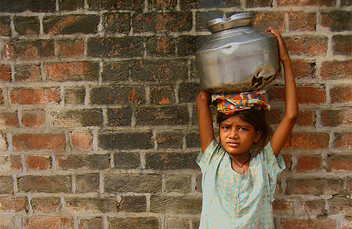Conflicts in northeast Kenya have been intensifying as drought worsens an already growing problem over access to water and land for pasture. In Pakistan, wheat production is expected to decrease by 40 percent this year due to water scarcity.
Is this evidence of society approaching what the World Economic Forum refers to as water bankruptcy? According to a recently released report by the WEF Water Initiative, under-pricing and inefficiencies in the regulation of water have led to unsustainable "regional water bubbles," which are already beginning to burst in Asia, the Middle East, and parts of the United States.
More than 1 billion people currently lack access to clean water, and that number is predicted to double by mid-century, according to Professor Wong Poh Poh of the National University of Singapore. Less than one percent of the earth's water is available for human consumption, a situation exacerbated by population growth, industrialization, climate change, and poor resource management.
The Pitfalls of Privatization
The WEF report predicts that a number of public-private partnerships will be formed to change the ways in which urban water supplies are managed and financed. However, the private sector role in water provision has been a subject of intense debate for decades.
The CEO Water Mandate put forth by the United Nations Global Compact has come under fire for this very reason. Its goal is to "assist companies in the development, implementation and disclosure of water sustainability policies and practices," but the approach has been protested by 125 organizations, including Sierra Club and Polaris Institute. These organizations contend that the CEO Water Mandate, which is only open to corporate endorsers of the United Nations Global Compact, allows companies with questionable environmental records to gain greater control over water while requiring only voluntary commitments to conservation.
While some argue that private investment helps make the water industry more efficient by introducing new sources of financing, technology, and expertise, others maintain that water is a universal human right and therefore should remain in public control. Currently, more than 90 percent of the world's water supply is publicly owned and operated.
Residents of urban slums rarely have any access to publicly allocated water. Instead they rely on vendors who charge on average 12 times more than the cost of water from municipal pipelines. In some cases, the rates can reach as much as 100 times the price of piped supplies, and water bought from vendors often has to be boiled before it is safe to use, further increasing the cost.
In the 1990s, multilateral institutions such as the World Bank and the International Monetary Fund began conditioning loans on the requirement that countries privatize their water services. Private sector involvement can range from full corporate control of assets and operations to public-private partnerships where governments retain the ability to establish rates.
Over the past two decades, water privatization initiatives have helped millions of people in developing countries obtain access to clean and safe water. But in order to recover costs, companies have generally had to implement rate hikes for those already connected to main water supplies.
Water privatization in South Africa resulted in rate increases of up to 600 percent for some households. According to the Municipal Services Project, 10 million South Africans had their water cut off between 1994 and 2002, and 2 million people were evicted from their homes for not paying utility bills. After turning to polluted rivers for water, more than 120,000 people in the KwaZulu-Natal region were infected with cholera and hundreds died.
The water industry generally produces low rates of return on investment, and risks are even greater in developing countries. Suez subsidiaries eventually pulled out of their contracts in Argentina and the Philippines after going into debt partly due to extreme devaluations of the local currencies. Violent protests in Cochabamba, Bolivia, caused by sudden and severe rate hikes drove the Aguas del Tunari consortium to terminate its contract just months after it took control of the city's water supply system.
Water companies are pulling out of more and more poor countries, and a number of governments at local, regional, and national levels are remunicipalizing water services in the wake of failed privatization attempts. New laws in Uruguay and the Netherlands go so far as to make private sector involvement in the water industry illegal [Opens Word doc].
Some argue that instead of rejecting private sector involvement entirely, it should be better managed. The water industry has been urged to adapt more competitive bidding procedures, greater reliance on local investors, stronger regulatory provisions, and transparent contract negotiations that include consultations with local residents and nongovernmental organizations. It's also been suggested that when sliding-scale pricing schemes are impractical, governments or lending institutions should be expected to subsidize rates.
New Water Metrics
A number of innovative initiatives have emerged to help individuals, companies, and governments conceptualize and measure water usage.
Mike Tuffrey, director of the UK consultancy Corporate Citizenship, has recommended that companies prioritize lower water use over cutting carbon emissions. He also predicts that "water footprinting" will soon be expected of corporations. The Australian government has already implemented a water efficiency labeling scheme to help the country's consumers reduce water consumption.
The concept of "virtual water" has also been introduced to consider the amount of water that goes into producing tradable goods. For instance, an apple requires 70 liters of water, while a cotton t-shirt needs 2,700 liters. One kilogram of beef can require up to 15,500 liters of water. Virtual water can be used to help water-scarce regions import water-intensive products from places with easier access to water and more efficient production methods.
Beyond improvements in efficiency and allocation, some companies and regions are pursuing technical solutions such as converting seawater and sewage into purified water. Orange County, California's Groundwater Replenishment System unveiled one of the first and largest "toilet-to-tap" systems in the country early last year. Concerns have been raised, however, over the amount of energy these processes consume.
As water scarcity is fast becoming everyone's problem, it will take all parties to the debate working creatively to come up with solutions. The economic stimulus bill signed this week by President Obama includes billions for water projects in the United States. But when compared to the global water problem, some are left wondering whether this is a drop in the bucket, or whether the glass is half full.




